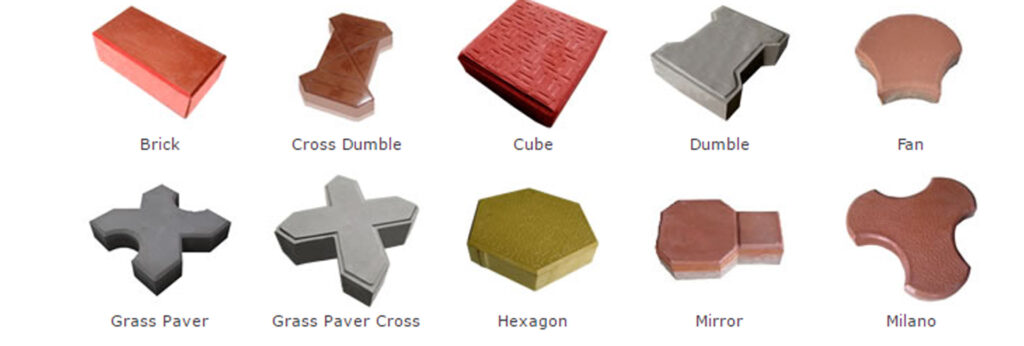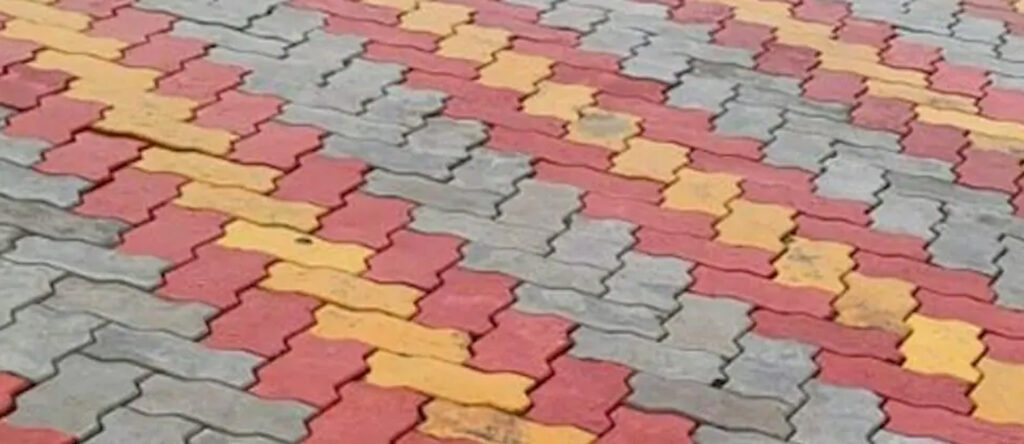Paving blocks (also known as pavers, interlocking paving stones, or concrete pavers) are precast concrete units used for constructing pavements, walkways, driveways, and other surface coverings. These blocks are designed to interlock or fit together without the need for mortar, creating a stable and flexible surface. Paving blocks come in various shapes, sizes, and colors, allowing for versatile designs in both residential and commercial settings.
1. Composition
Paving blocks are typically made from:
- Cement: The primary binding agent in paving blocks.
- Aggregates: Sand, gravel, or crushed stone used to provide structure and strength.
- Water: To activate the cement and form the concrete mixture.
- Admixtures: Chemicals like plasticizers, retarders, or accelerators are sometimes used to improve the workability or strength of the mix.
Paving blocks may also include other materials, such as:
- Pigments: For coloring the blocks in a variety of shades.
- Reinforcing agents: Steel or fiberglass may be added to improve the strength and durability of the blocks.
2. Manufacturing Process
Paving blocks are produced in a controlled environment, usually at a manufacturing plant, and undergo several stages:
- Molding: Concrete is poured into molds designed for specific shapes and sizes, often using vibration or compaction to ensure density.
- Curing: The molded blocks are then cured under specific temperature and humidity conditions to ensure that the blocks achieve maximum strength and durability.
- Quality Control: Before the blocks are released for sale, they undergo testing for compressive strength, dimensions, and finish quality.
3. Types of Paving Blocks
There are various types of paving blocks designed for different applications:
- Interlocking Paving Blocks: These have edges that interlock with adjacent blocks, which provides a stable and flexible surface. These are widely used in driveways, walkways, and parking lots.
- Rectangular or Square Blocks: Simple, uniform-shaped paving blocks commonly used for straightforward pavement designs.
- Hexagonal or Other Shape Blocks: Decorative paving blocks that can create interesting patterns, often used in gardens, pathways, and plazas.
- Permeable Paving Blocks: Designed to allow water to drain through the gaps between the blocks, these are ideal for areas where water runoff needs to be managed, such as driveways or public squares.
- Textured or Patterned Blocks: These blocks may have a textured surface or decorative patterns that enhance the aesthetic appeal of outdoor spaces.
- Cobblestone Pavers: Smaller, stone-like pavers designed to mimic the appearance of traditional cobblestones, often used in historical or rustic-themed landscapes.
- Brick Pavers: Similar to traditional bricks but made from concrete, often used for a classic or vintage appearance.

4. Advantages of Paving Blocks
- Durability: Paving blocks are highly durable and can withstand heavy loads, making them suitable for both pedestrian and vehicular traffic.
- Easy Maintenance: If a block becomes damaged, it can be easily replaced without disturbing the surrounding pavement. This reduces long-term maintenance costs.
- Versatility in Design: Paving blocks come in various colors, shapes, and textures, allowing for endless design possibilities for both functional and decorative purposes.
- Water Drainage: Many types of paving blocks, especially permeable blocks, allow water to drain through, reducing the risk of surface water accumulation and contributing to effective stormwater management.
- Slip Resistance: Textured surfaces of paving blocks provide natural slip resistance, making them safe for use in wet conditions, such as in pool areas or outdoor steps.
- Eco-friendly: Permeable pavers contribute to sustainable development by reducing the heat island effect and promoting water absorption, which helps recharge groundwater supplies.
- Cost-Effective: Paving blocks are relatively inexpensive compared to other surface covering materials like asphalt or granite, making them a budget-friendly choice for residential and commercial projects.
5. Applications
Paving blocks are suitable for a wide range of applications, including:
- Driveways: Paving blocks are popular for driveways due to their durability, easy maintenance, and aesthetic appeal.
- Walkways and Pathways: Ideal for creating pedestrian paths in gardens, parks, and residential landscapes.
- Patios and Courtyards: Paving blocks can create attractive and durable outdoor living areas, often with intricate patterns and designs.
- Parking Lots: Interlocking pavers are commonly used in parking areas due to their load-bearing capacity and the ability to create stable, well-drained surfaces.
- Streets and Plazas: In urban settings, paving blocks are used for pedestrian streets, plazas, and public spaces where both functionality and aesthetics are important.
- Pool Decks: Their non-slip surface makes paving blocks a great choice for poolside areas, where water drainage and safety are essential.
- Landscaping Features: Used to create retaining walls, garden edging, and decorative elements like steps or garden pathways.
6. Design Flexibility
Paving blocks offer significant design flexibility:
- Pattern Variations: By combining different shapes (square, rectangular, hexagonal) and colors, complex patterns such as herringbone, basketweave, or circular designs can be created.
- Color Customization: Pigments are added during manufacturing, allowing paving blocks to come in a variety of colors like red, gray, beige, or earth tones. Custom colors can also be made on request.
- Surface Finishes: Paving blocks can have different finishes like smooth, rough, or textured. They can also be exposed aggregate for a decorative finish that reveals the underlying stones or gravel.
- Edge Treatments: Paving blocks can be manufactured with rounded or beveled edges, allowing for smoother transitions between the blocks and minimizing the risk of tripping.

